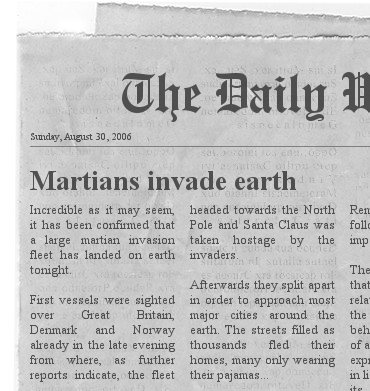Well, that sucked.
Flooded my mother fucking game room!
It could have been worse, but it sure as hell coulda been better. When I got there it was standing about 1.5 inch deep. We don't keep too much shit on the floor that isn't in a plastic tub or raised up on metal shelves, and the floor is rather uneven, which saved my book cases from the worst of it. So I get down with the shop vac and start pumping while Celeste starts making dams to keep the water out of the art studio, where shit is all over the fucking place. The studio is a bit higher than the rest (again, wobbly floor saves the day) so she had a bit of time to work, despite the rising water.
Once we got that shit under control I started poking around the crawl space under the house, trying to find the source, and find it I did. There's a drainage trench through the crawl space, with a drain pile laid through it. That bit was full to over flowing, just over a foot deep, with more coming in through the backed up french drain. So I go out and buy a pump and toss that bitch in. About 2 hours later its got the trench drained most of the way, and we spend the rest of the night manning the bilge: 2 hours on, 2 hours off (more of less): drain it out, let it fill back in, drain it out again.
It is filling up slower this morning than last night, but its still coming in, and still raining, so we'll have to keep an eye on it. It wasn't TV news grade flooding with people rowing boats down the street or anything, but it was a hell of a lot more water than I'd typically invite into my house, especially since I've never had a house flood before.
I wish I'd taken pictures. Oh, I left out the funny bit: scrambling around cleaning up endangered nerd artifacts my wife knocked over a pile of stuff, including a few still-packeged toy dragons and a copy of Risk in the shrink wrap. They floated.
Thursday, March 11, 2010
Tuesday, March 9, 2010
FoW - Walt Assaults Endor
I ran another teaching game of Flames of War in the basement this past weekend, this time with my old buddy, Walt. I didn't put quite as much time into the table for this one, so its not quite as fancy, but it sure was dense! Probably a little too dense, but hay, he's the one who out out all the tree stands. We played "No Retreat," from the Firestrom: Bagration book. I did a good bit of coaching aside from just teaching the rules, so Walt learned a bit more about what works and what doesn't and I still got some valuable insight into how to run a paratrooper army.
As the German Panzergrenadiers hastily prepared their support positions...
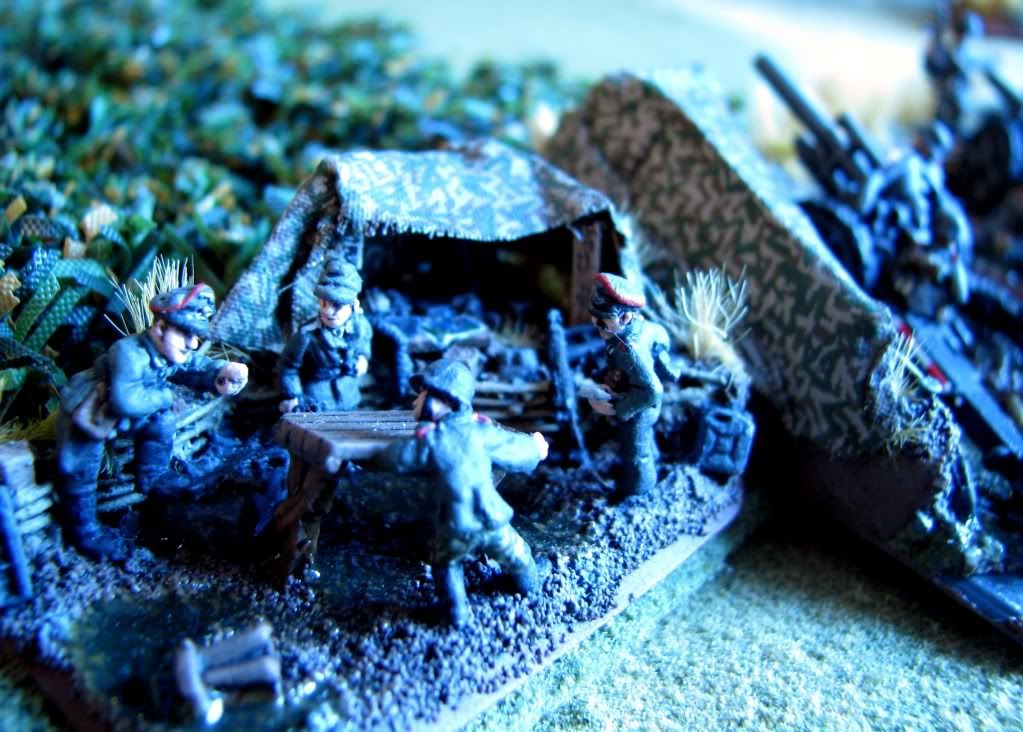
...the paratroopers of Easy Company dug into the woods through the center of the table.
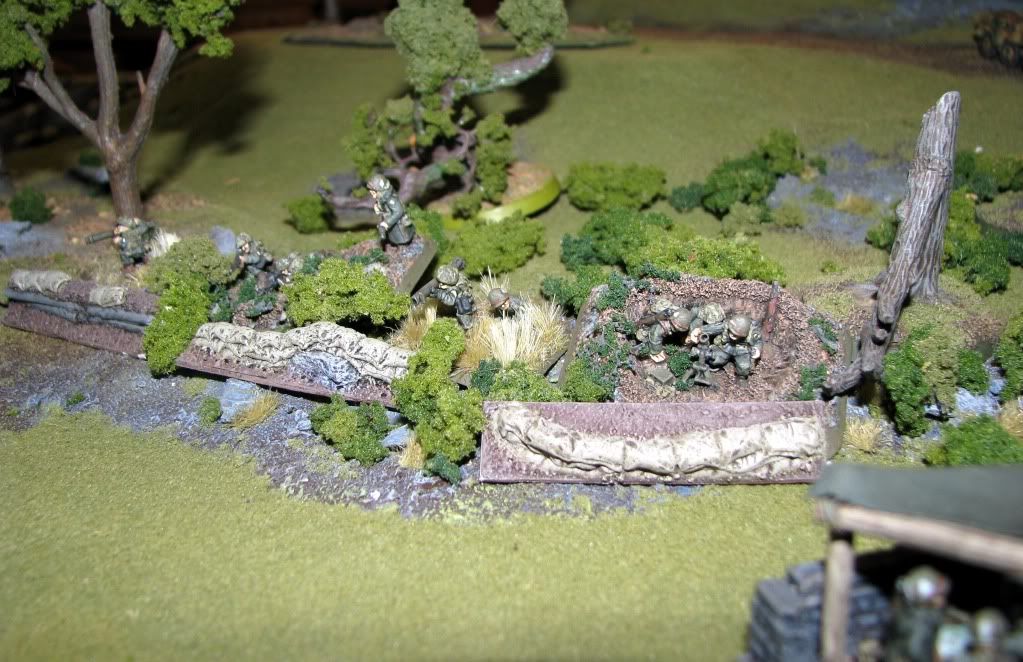
Finally, the German attack was ready to begin.
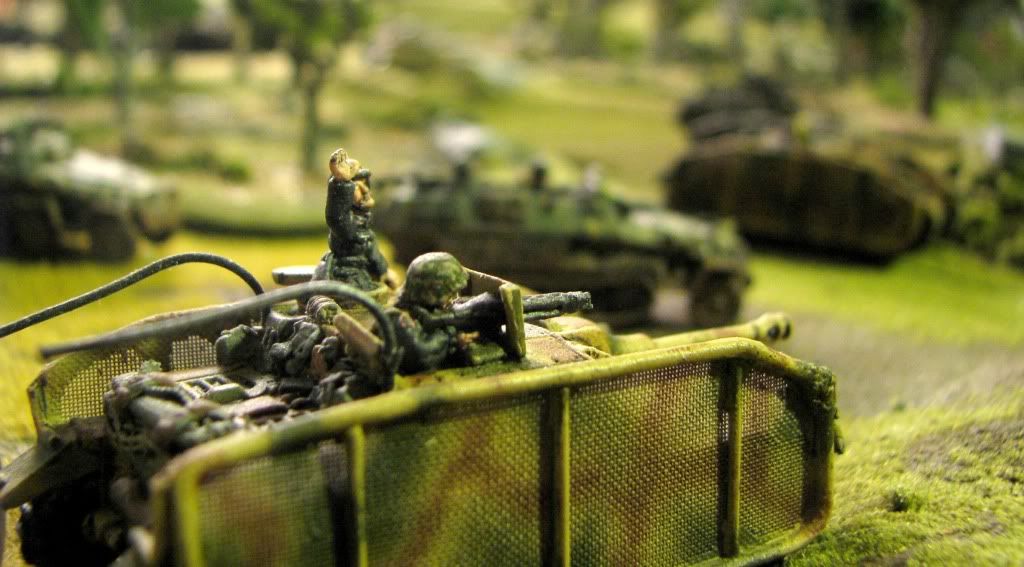
Breaking his force up into two columns, each with a Panzer platoon and a Panzer Grenadier platoon, Walt began his advance with one group going up the center, the other through the woods on his right flank, and scouts advancing along the high ground to his left. My boys laid low, and I tossed a few artillery templates at him, to no affect.


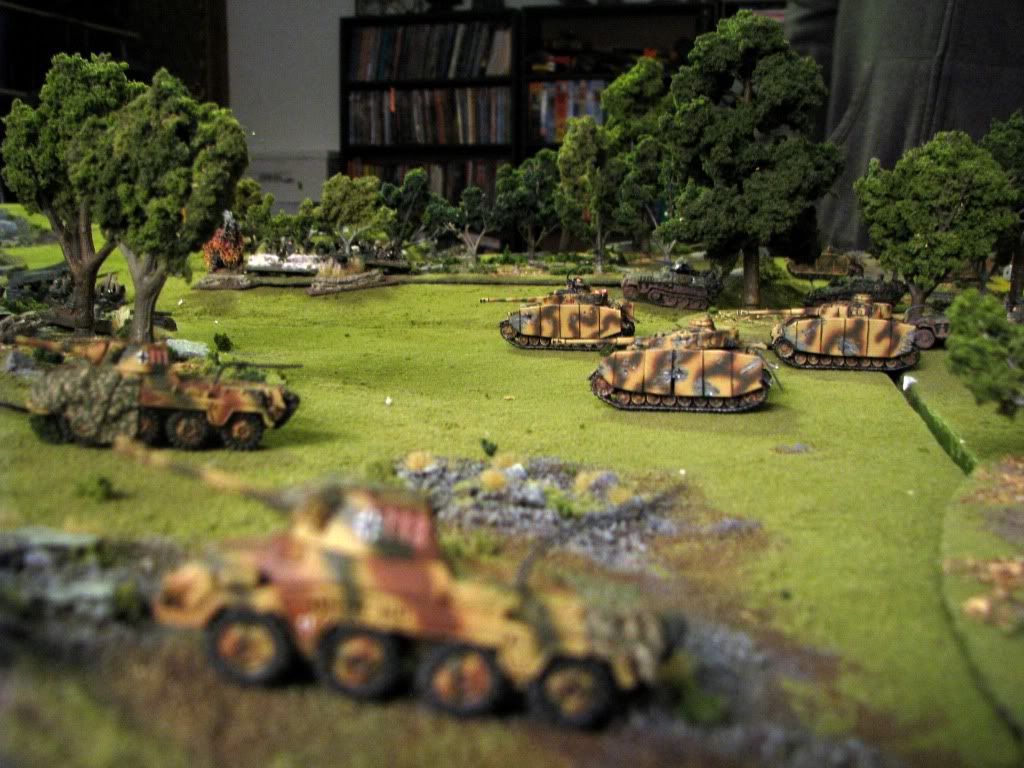
By Turn 2 he was ready to kill him an observer.
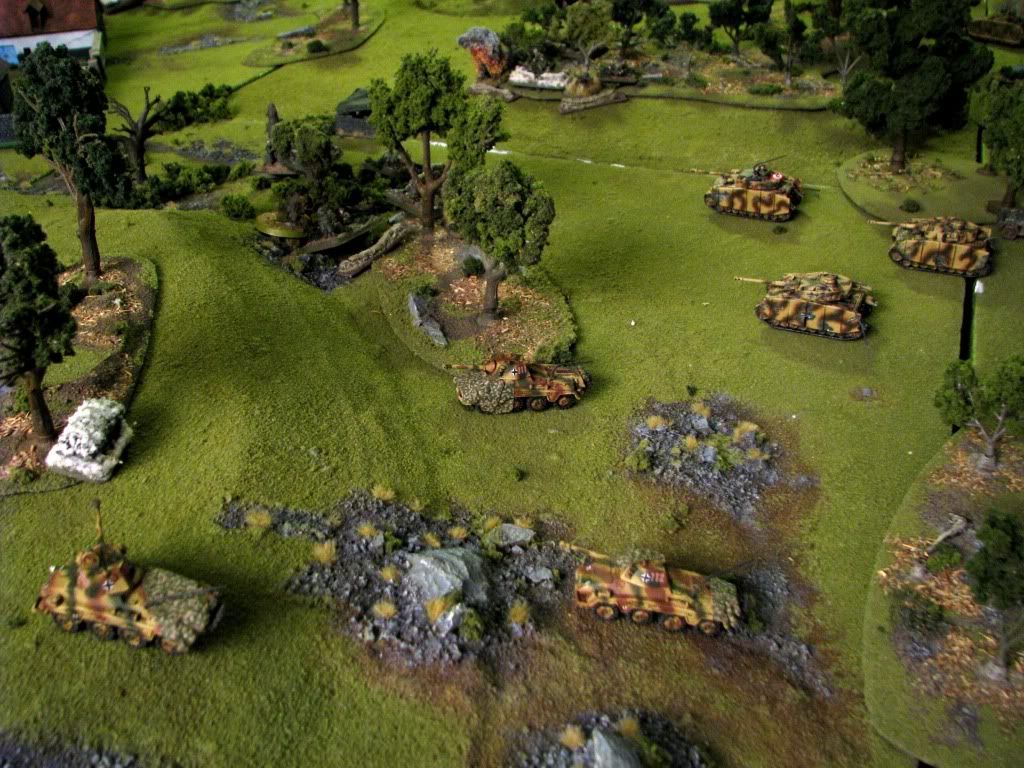
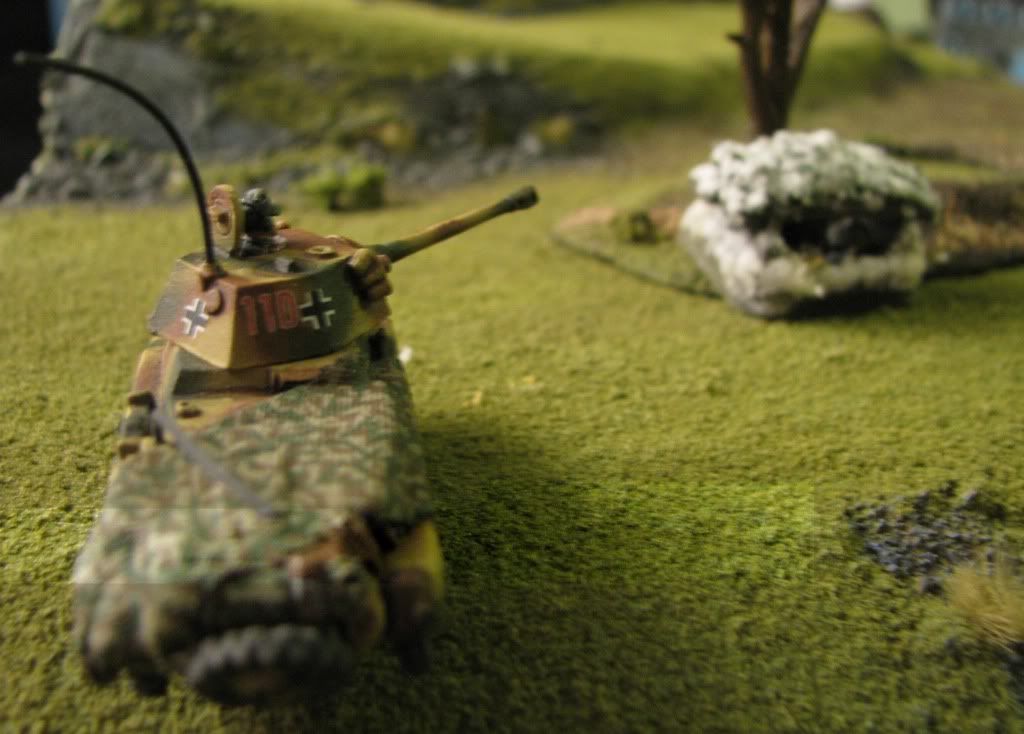
Meanwhile, my boys explained to his tanks the concept of the 3+ infantry save, plus fox holes, giving the impression that Flames of War does, in fact, love infantry.
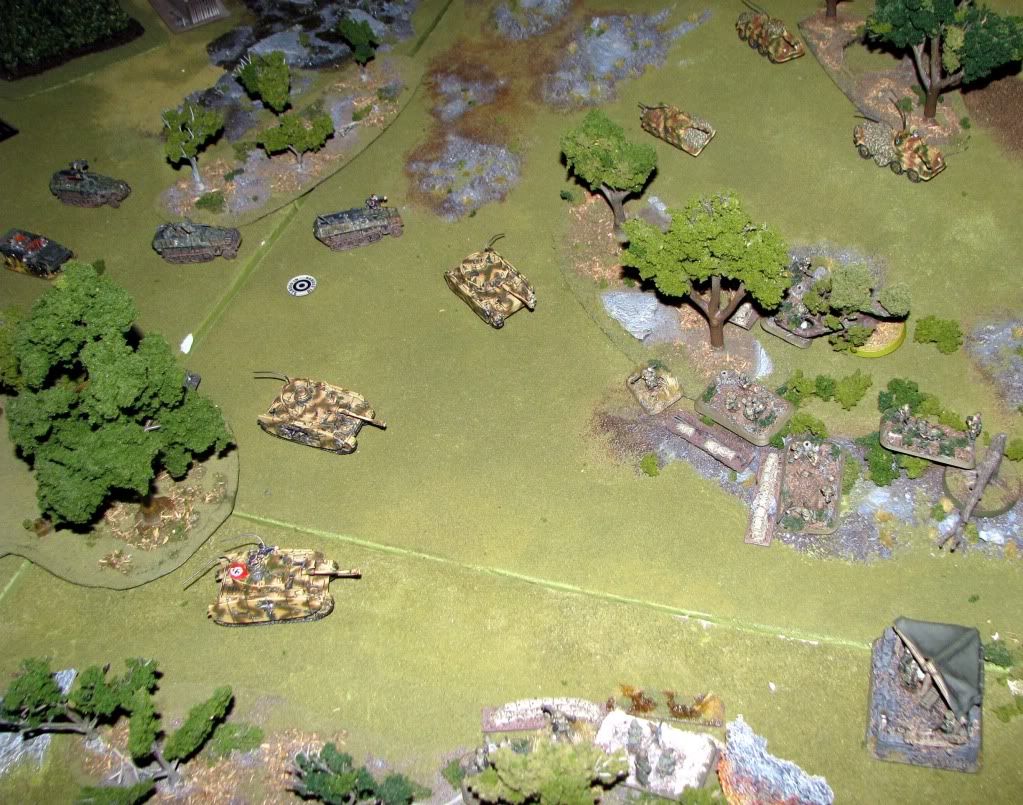
It wasn't a bad idea, going in tanks first, and he tried it on both sides:
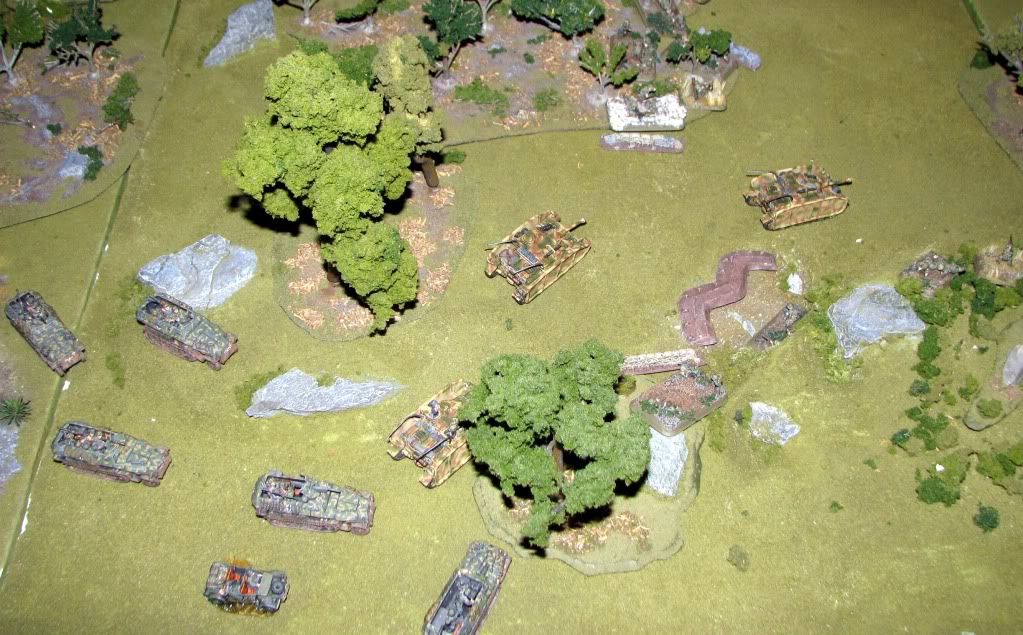
I tried to tell him (OK, I tried to imply and suggest, without coming right out and saying it,) but these tanks don't know how fucked they are:
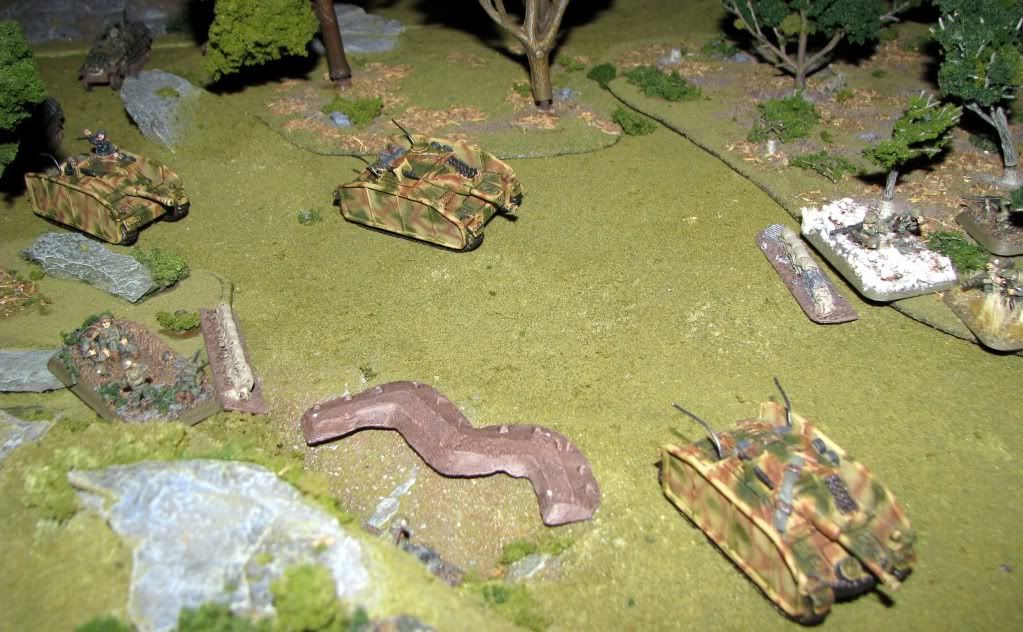
They learned.
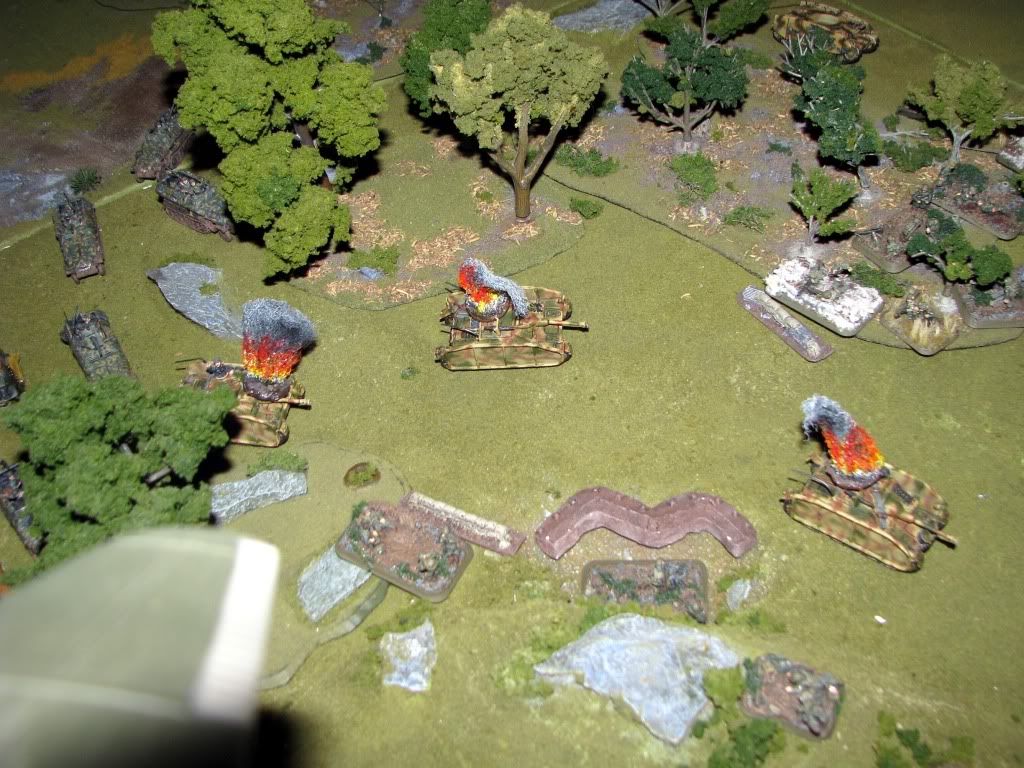
After Turn 2, there were tater tots and pizza bites. My wife rules.
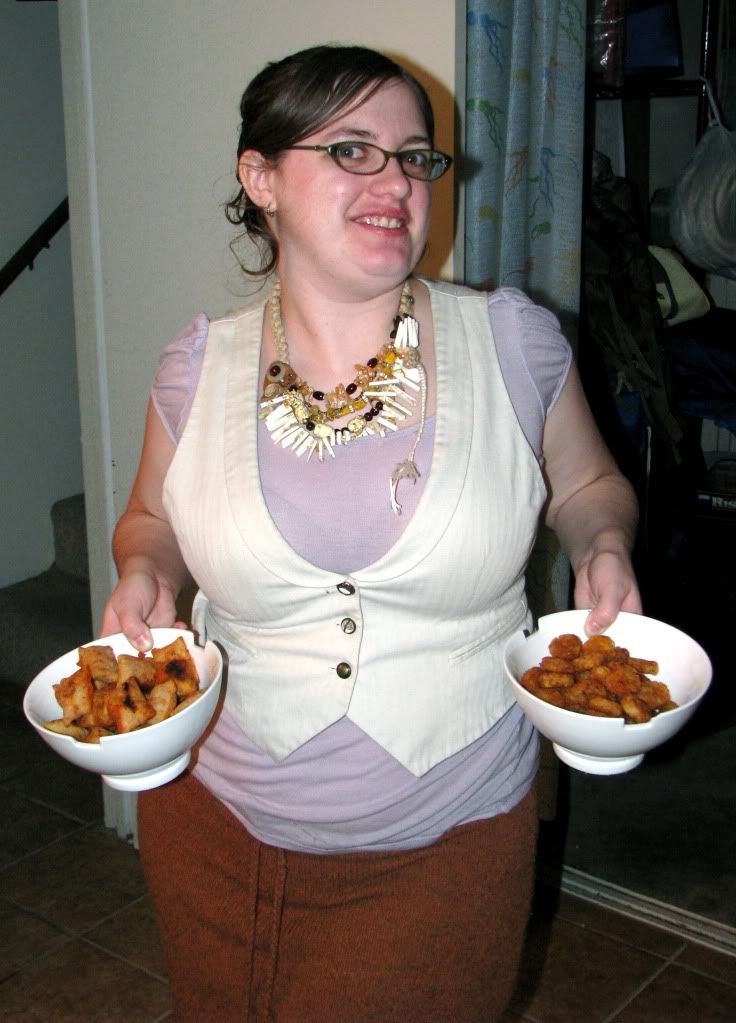
He was doing basically right, trying to hit me with his tanks while he got his infantry ready, he was just waiting way too close. The StuGs in the woods got mugged by infantry hiding in the woods and cave. The Panzer IVs up the middle got shelled into oblivion (two died and two ran away), and the Pumas never found anything better to do with themselves.
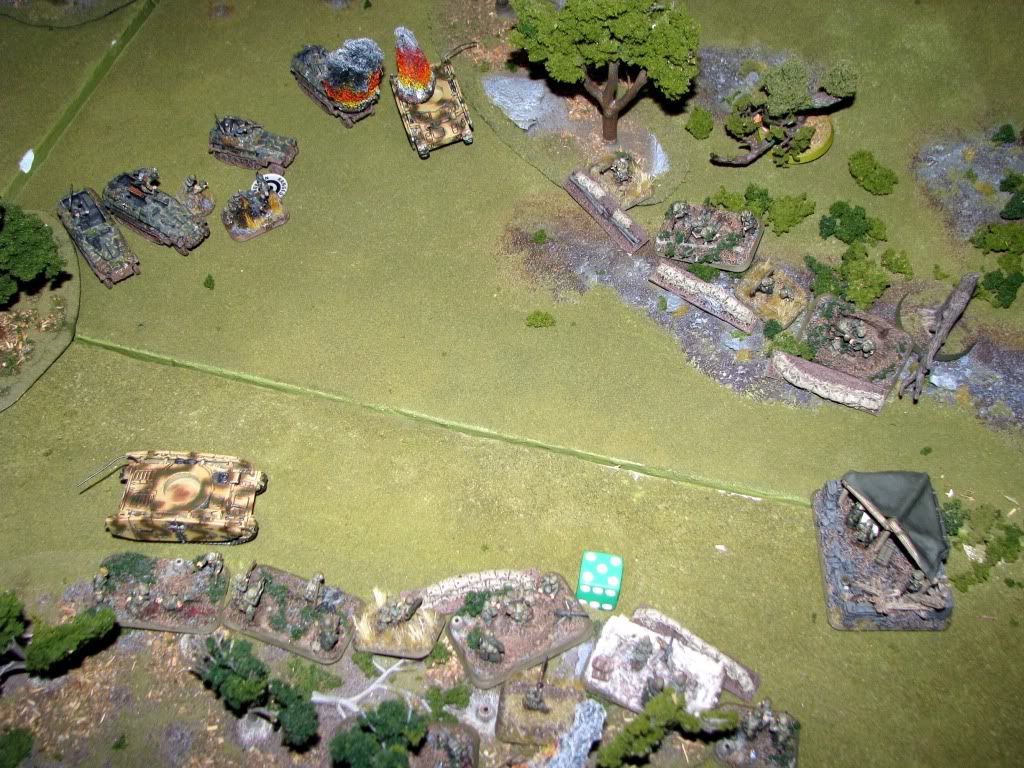
I think he'd been planning on assaulting my rear with them, but after seeing what happened to the StuGs they sort of hung back and watched the objective for a while.
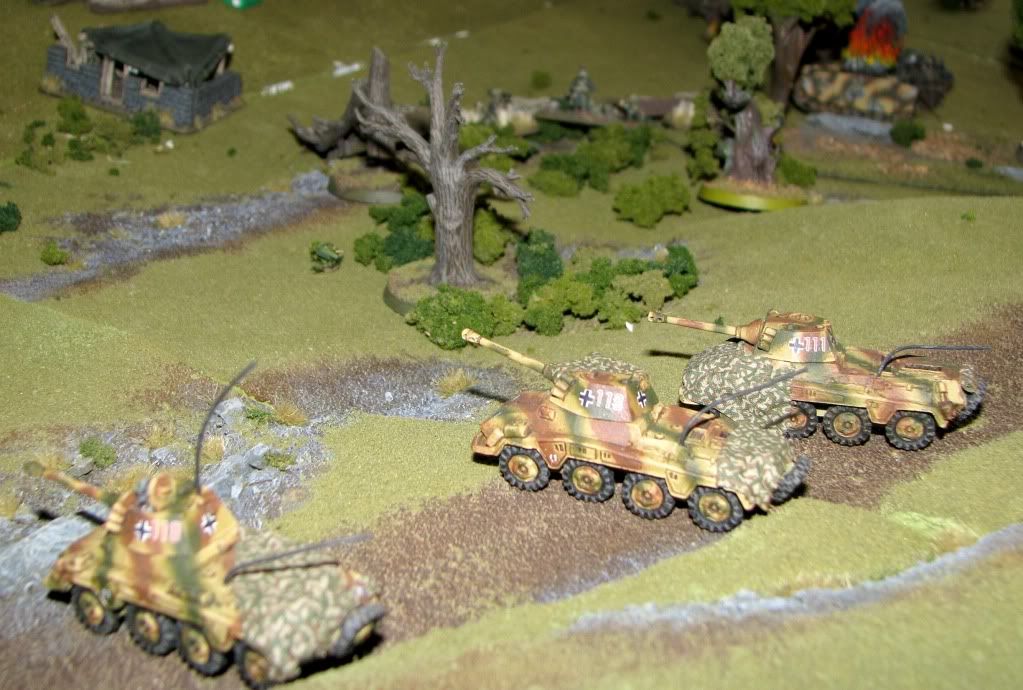
Turn 4 was where the real action was. It started in the woods on Walt's right flank, as the halftracks scraped paint against burning StuGs to get at my men and give the ol' Mounted Assault rules a try.
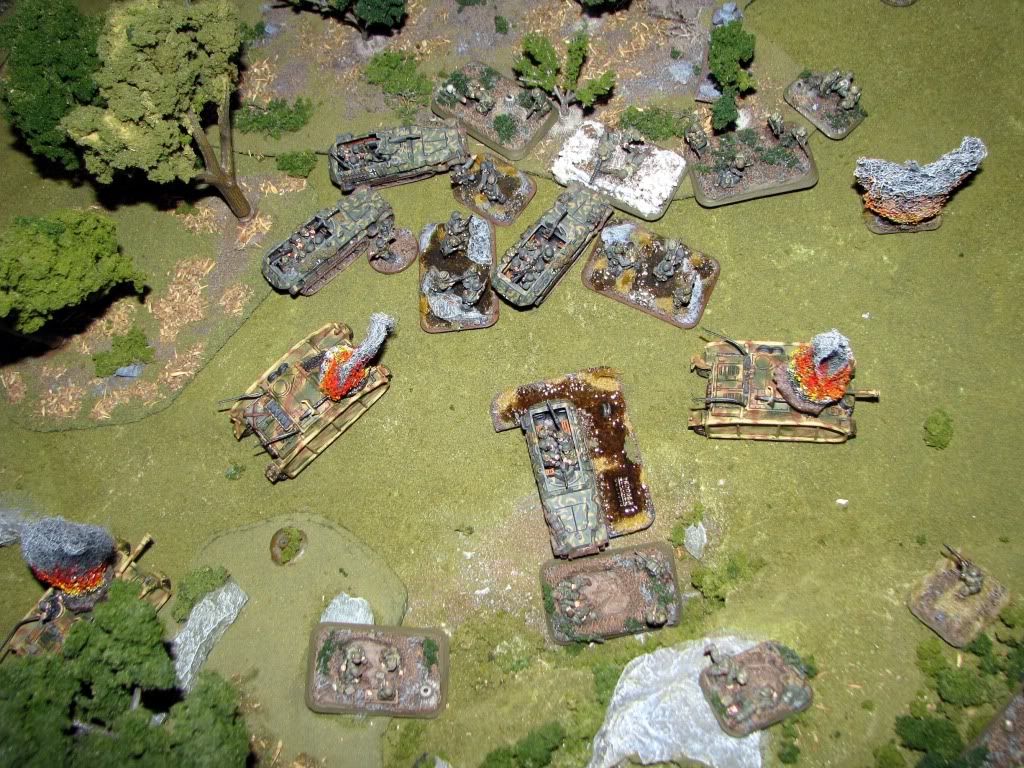
Suffice to say, they work better against pinned targets (I was really enjoying being Fearless in this game, I passed every moral check and he couldn't keep me pinned down.) Half his initial assault bogged down, either on the way in or after failing a moral check to counter attack.

I was sliding teams into the fight every chance I could get, even running up Lt. Speers for a little action.

It was a massacre, with fleeing Germans shot down in the woods and only halftrack crews surviving long enough to surrender.
In the center his now unsupported infantry gave it another try, but the results were largely the same.
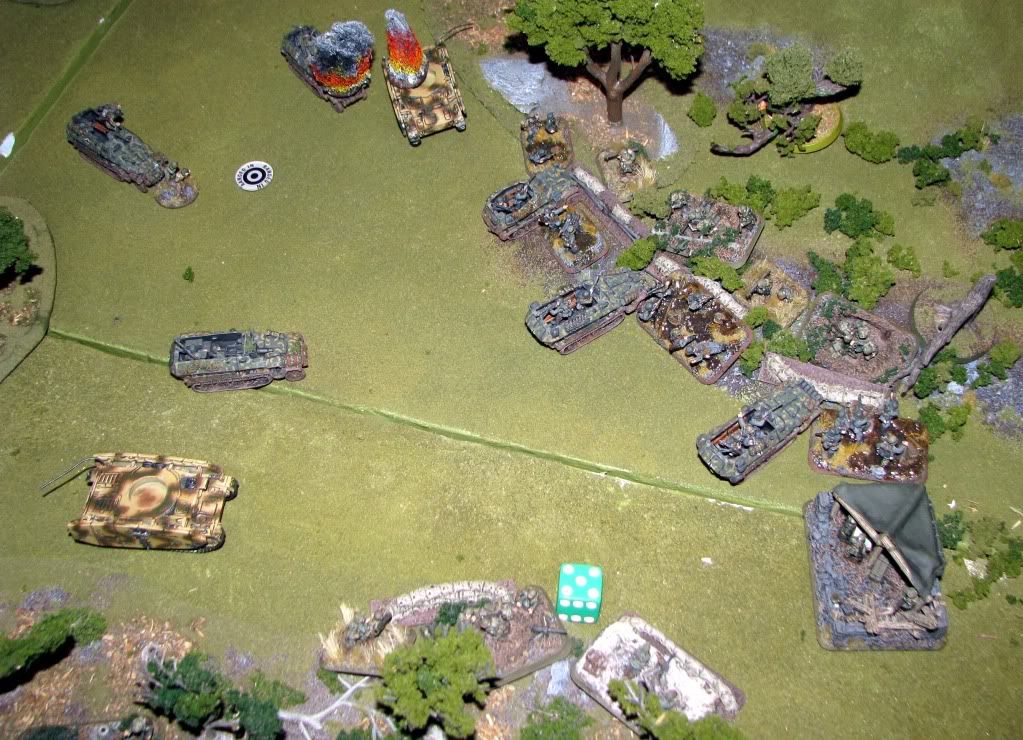
I didn't take a picture of them, but only a few German teams managed to get out of this fight.
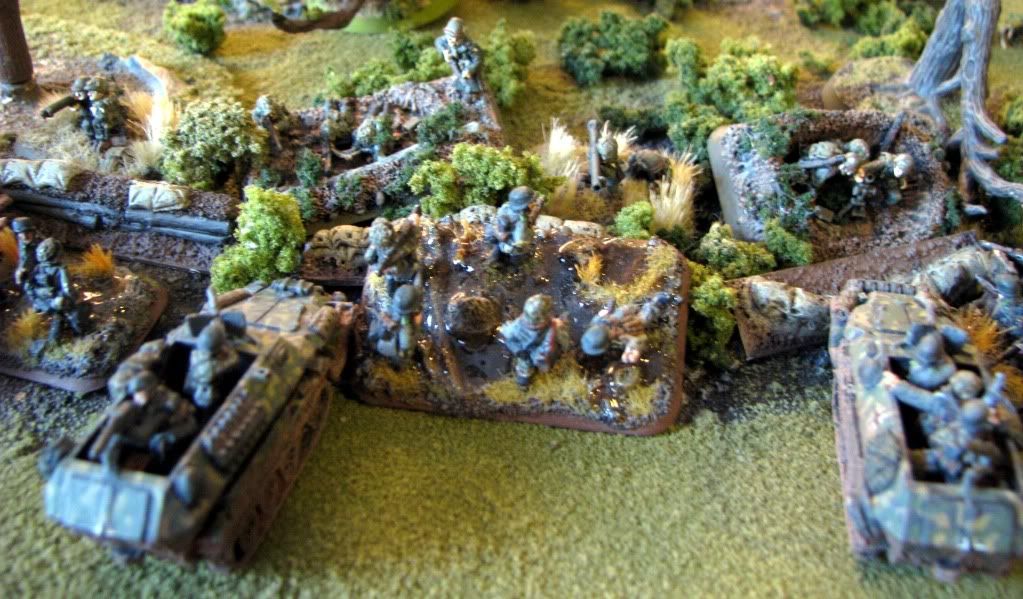
And all that was in his 4th Turn. At the start of mine, I rolled and got all my reserves at one go, like the US Army finally got into the war (and no, the bombers are just for the picture).
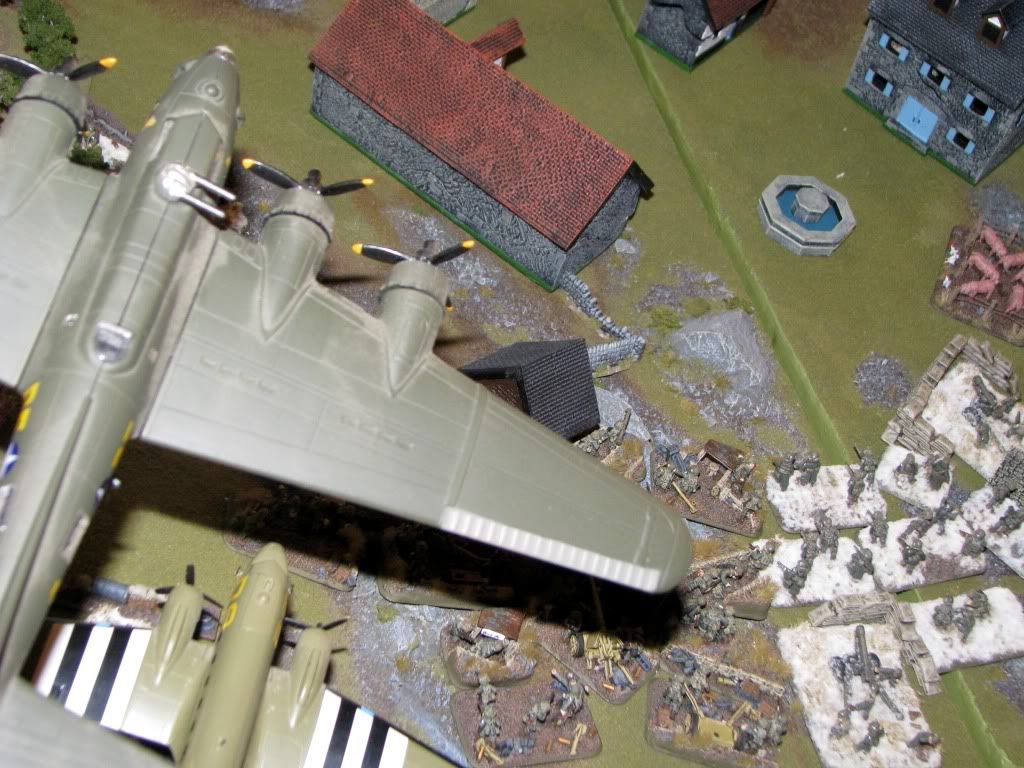
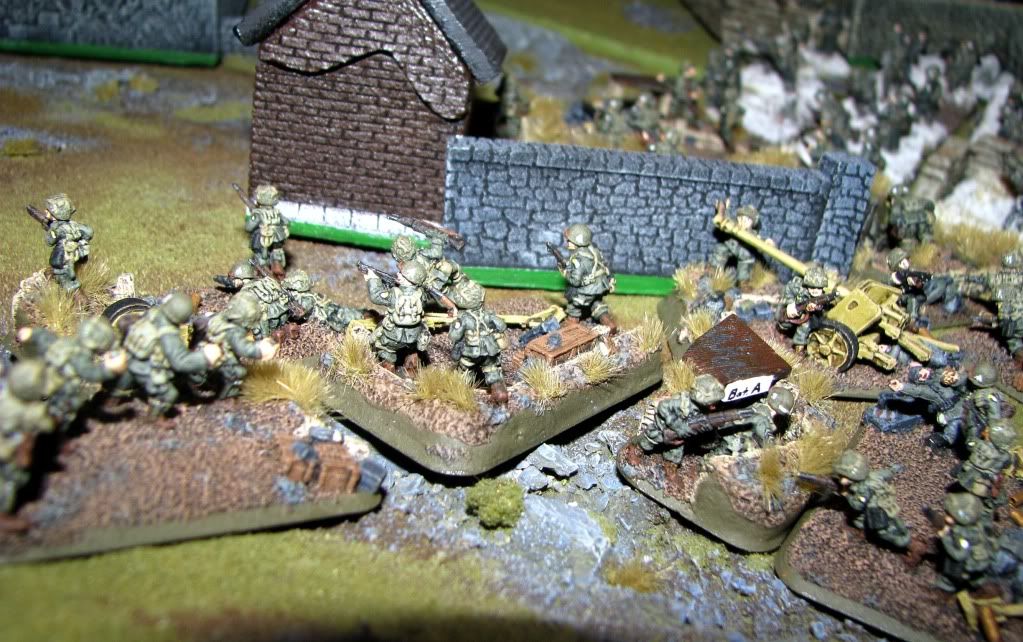
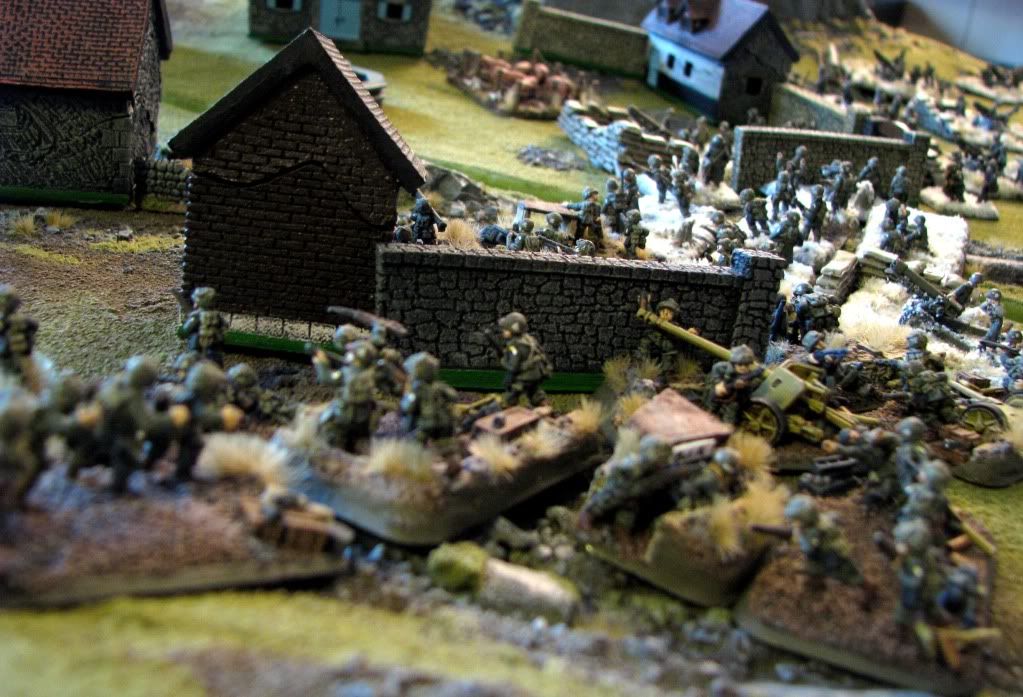
At this point all he had left was his artillery, the Pumas, and a few halftracks pretending to be a platoon, and we called it a night.
As the German Panzergrenadiers hastily prepared their support positions...

...the paratroopers of Easy Company dug into the woods through the center of the table.

Finally, the German attack was ready to begin.

Breaking his force up into two columns, each with a Panzer platoon and a Panzer Grenadier platoon, Walt began his advance with one group going up the center, the other through the woods on his right flank, and scouts advancing along the high ground to his left. My boys laid low, and I tossed a few artillery templates at him, to no affect.



By Turn 2 he was ready to kill him an observer.


Meanwhile, my boys explained to his tanks the concept of the 3+ infantry save, plus fox holes, giving the impression that Flames of War does, in fact, love infantry.

It wasn't a bad idea, going in tanks first, and he tried it on both sides:

I tried to tell him (OK, I tried to imply and suggest, without coming right out and saying it,) but these tanks don't know how fucked they are:

They learned.

After Turn 2, there were tater tots and pizza bites. My wife rules.

He was doing basically right, trying to hit me with his tanks while he got his infantry ready, he was just waiting way too close. The StuGs in the woods got mugged by infantry hiding in the woods and cave. The Panzer IVs up the middle got shelled into oblivion (two died and two ran away), and the Pumas never found anything better to do with themselves.

I think he'd been planning on assaulting my rear with them, but after seeing what happened to the StuGs they sort of hung back and watched the objective for a while.

Turn 4 was where the real action was. It started in the woods on Walt's right flank, as the halftracks scraped paint against burning StuGs to get at my men and give the ol' Mounted Assault rules a try.

Suffice to say, they work better against pinned targets (I was really enjoying being Fearless in this game, I passed every moral check and he couldn't keep me pinned down.) Half his initial assault bogged down, either on the way in or after failing a moral check to counter attack.

I was sliding teams into the fight every chance I could get, even running up Lt. Speers for a little action.

It was a massacre, with fleeing Germans shot down in the woods and only halftrack crews surviving long enough to surrender.
In the center his now unsupported infantry gave it another try, but the results were largely the same.

I didn't take a picture of them, but only a few German teams managed to get out of this fight.

And all that was in his 4th Turn. At the start of mine, I rolled and got all my reserves at one go, like the US Army finally got into the war (and no, the bombers are just for the picture).



At this point all he had left was his artillery, the Pumas, and a few halftracks pretending to be a platoon, and we called it a night.
Monday, March 8, 2010
Liquitex
 Artists Acrylics for WarGamers
Artists Acrylics for WarGamersThis is something of an expanded answer to a question from the local game forum, where someone asked me which of their bewildering array of products I used as the basis for mud on vehicle fenders. Since I use a decent handful of their products, I figured I'd comment on a few of them and how they might be useful for the wargamer and miniature painter. Liquitex has been making artist-grade acrylic paints since 1955, and are pretty much the standard in that industry. Their products are commonly available at artist supply shops and the big retail craft stores; I tend to get mine from Hobby Lobby. It seems they've removed most of them from the shelf displays, but they used to post little samples of each product next to the price tag, so you could see what you were getting into. Made picking the right medium a lot easier. Oh, well.
Lets take a look at what I've got and what its good for. All of these are non-yellowing, clear-drying, water-clean up but not water soluble when dry (so you can ink over them and such). Note that I'm quoting the product names directly from the labels, which have been redesigned since I got some of mine. For instance, with the new label designs the older "Natural Sand Texture Gel," is probably just called "Natural Sand," as "Resin Sand," is also a texture gel, it just doesn't say so on the new label.
Fluid Mediums:
Both brush-painting Mediums have nice leveling properties, which means you don't see the brush strokes nearly so much when you've mixed them in. You can also drybrush with paint mixed with these without getting that "chalky" look so bad. You'll probably want to thin your paint a bit with water when using these, as they both tend to thicken things a bit, which can also be a good thing. Basically, paint will go on smoother and with greater transparency, but you might want to thin it for better flow, which will further increase the transparency (which may itself be a good thing).
Airbrush Medium
A nice thinning fluid for airbrushing acrylics in general, the Liquitex offering is interesting to us because, if memory serves, it is the only thinner out there that will thin Vallejo model color for airbrushing without forming those stringy little boogers that give away the paint's latex origin. In general I airbrush with the paint manufacturer's thinner, and I'd recommend you go with the manufacturer's recommendations over this product when applicable, but with Vallejo you'll probably be special ordering that stuff, and this is handy.
Matte Medium
This stuff is basically acrylic paint without any pigment. You can extend paint with it, and it reduces transparency, but its not really a glazing medium. If you've got need for a thickening agent, something to just bulk up the paint at make it much more viscous, this is the ticket. It dries with a flat finish, but its not very good for glazing.
Glazing Medium
You'd think this would be obvious, but it wasn't to me (how do you think I ended up with Matte Medium?). This is the stuff you want for painting glazes, even though it says it dries glossy. It does, very glossy in fact, but a clear spray coat takes the shine right off. I've been experimenting with this stuff on the Space Hulk figures I'm painting, and I love it. It takes a lot of time, but you can really build up a nice color fade that feels like it has depth.
Gel Mediums:
The Gel mediums are really what attracted me to Liquitex in the first place, and they are what we were talking about on the forum. These are not intended to be brushed on at all: they are quit thick, and will hold much of the shape you give them - not enough to sculpt with, but instead of helping level out your brush and knife (you'll mostly be smearing these, I use ancient crappy brushes) the gel holds the shape you put it in. The dry slow, and stay a bit flexible when dry, so they won't chip off, and they have quite a bit of "body" to them, which stays somewhat bulky when dry. You can add colors to them, or use them clear. If needed they can be thinned with water, but you'll usually want them pretty thick.
Resin Sand
Thick, course sand (multiple size grains) suspended in gel. I haven't used this one very much, it was an idea for a project that went no where. But if you wanted to you could use these as basing pastes, either by adding paint and spreading it over the finished piece, or by applying it before priming and painting.
Natural Sand Texture Gel
I love this stuff, and use it for all manner of "add some light texture there," jobs. The sand is very fine and very uniform, so it come out much less lumpy when dry than the Resin Sand.
Vehicle Mud: Mix with a medium brown color -- the "dirt" on my miniatures is typically a 3-color shade (paint dark brown, drybrush middle brown, highlight with light brown) and to match the vehicles to the troops I mix just a dab of the middle brown into the Natural Sand gel, then apply it to fenders, etc. where mud would collect. When dry, I lightly drybrush with the army's dirt highlight color.
Snow: It wouldn't do the job alone, but nothing else would, either. Natural Sand acrylic gel is the base for my custom snow paste mix (I add water, paint, and flock as well), but I'll be talking more about that later.
Subscribe to:
Comments (Atom)

